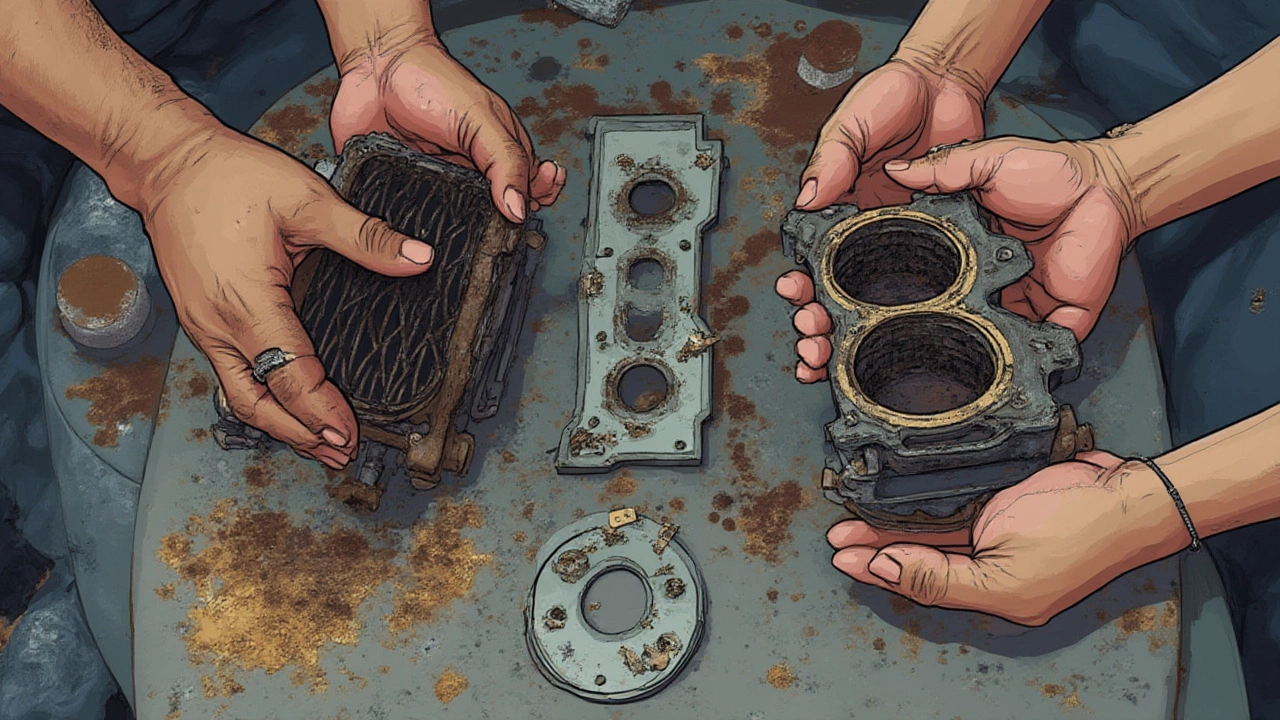Car problems have an uncanny way of showing up when you least expect them. You’re on the way to work, running late, and suddenly the temperature needle jumps into the red. The panic is real. Is it something simple, like a radiator issue, or are you in for a nasty surprise—like a blown head gasket? If you can tell the difference early, you can dodge even bigger headaches (and hefty repair bills). Missing the clues, on the other hand, can make everything much worse.
What Does Your Cooling System Actually Do?
Before diving into clues and fixes, it helps to know why your car cares about radiators, gaskets, and coolant in the first place. Your car’s cooling system is designed to keep the engine at just the right temperature—not too hot, not too cold. The radiator is the big player up front, channeling air and keeping that coolant nice and chilly as it flows around the engine. But it’s not working solo. The water pump, thermostat, coolant hoses, and, yes, the head gasket all pitch in (and can all cause trouble).
When you see steam or the dashboard warning light blinking, it means something in this crew isn’t pulling its weight. Ignore it, and the engine can warp, seize, or crack. According to AAA, cooling-system failures rank among the top reasons for roadside breakdowns. Surprisingly, most of these breakdowns could have been dodged with a closer eye on coolant leaks and fluctuations in the temperature gauge. The numbers don’t lie. A 2023 study by CarMD showed that around 17% of check engine light visits in the US were related to cooling system issues, many caused by overlooked radiator or gasket faults.
Spot the Difference: Radiator vs. Head Gasket Symptoms
This is where things get tricky. A failing radiator and a blown head gasket can both lead to overheating, steam, and a mess under your hood. But each leaves unique fingerprints. Catching those differences can save you some serious cash and stress.
Classic radiator problems usually start with visible coolant puddles under the car, especially if you park in the same spot every night. If you notice crusty, greenish or orangey deposits around the radiator, hose connections, or on the cap, you’re seeing leaked coolant drying up—a typical radiator clue. Another giveaway: your heater isn’t working right in cold weather (since the radiator is part of that loop too).
Now, a blown head gasket? That’s a sneakier beast. Here’s what to look out for:
- White smoke coming out of the exhaust, especially on startup (that’s coolant getting burned in the engine).
- Milky sludge on your engine oil dipstick or under the oil cap (coolant mixing with oil—never a good sign).
- Constantly low coolant with no clear leaks under the car. The gasket lets coolant sneak into the cylinders instead.
- Bubbles in your coolant reservoir—almost like it’s boiling when it shouldn’t be.
- Engine running rough or with poor power (combustion is being messed up by coolant leaks inside).
In short, radiators want to show you leaks, while head gaskets try to hide problems inside the engine—until things get bad and expensive. If you spot white exhaust smoke and a snotty mess in your oil, suspect the head gasket immediately.
Compare the two side by side:
| Radiator Problem | Head Gasket Problem |
|---|---|
| Visible coolant leaks under car | White smoke from exhaust |
| Crusty coolant residue around radiator parts | Milky oil/mayonnaise texture under cap |
| Overheating, slow to warm up in winter | Bubbling in coolant, rough idle, overheating |
Don’t want to play detective? A mechanic can do a “block test” to check for exhaust gases in your coolant, a sure-fire red flag for head gasket failure.

What Causes These Problems?
Every part wears out with time, but certain things make radiator or head gasket problems much more likely. Radiators usually go bad from corrosion (all those minerals in tap water can do a number on metal parts), rust, or physical damage—think rocks getting kicked up into your grille or minor fender benders. Even a loose or old radiator cap can wreck pressure and cause leaks.
Head gaskets, on the other hand, face a different kind of pressure—literally. They sit right between the engine block and the cylinder head, sealing in combustion gases and keeping coolant and oil from mingling. Repeated overheating is the main thing that kills a head gasket. If you ignore early radiator troubles, you can basically bake your head gasket into an early grave.
Engines designed with aluminum heads are a bit more prone to gasket failures because aluminum can warp faster than cast iron when overheated, and warpage means a leaky, ruined seal. Modern cars are actually a little more forgiving thanks to better gaskets and coolants, but pushing your luck with low coolant or ignored leaks is tempting fate.
According to Tom Torbjornsen, author and auto mechanic radio host, “A blown head gasket can lead rapidly from running rough to total engine failure, costing thousands. Early diagnosis is everything.”
Long story short: pay close attention to coolant levels and solve leaks as soon as you spot them. Every month, do a quick under-the-hood check for leaks, sludgy oil, or crusty radiator necks. Your wallet will thank you.
Smart Ways to Diagnose Radiator vs. Head Gasket Issues
Diagnostic tricks can separate the simple from the nightmare. If you’ve got a basic toolkit and aren’t afraid of popping the hood, some of these steps can reveal loads about what’s really wrong:
- Check the ground under your car each morning after parking overnight. Coolant leaks will show up as bright green, orange, or pink stains—an instant radiator clue.
- Inspect the coolant reservoir and radiator cap for discoloration, crust, or odd smells. Any sweet, burnt odor points to coolant issues.
- Open your oil cap: if there’s pale, milky goo underneath, coolant is mixing into oil—almost always a head gasket sign.
- With the engine cold, start the car and let it run. Watch the exhaust. Brief white vapor in cold weather is normal, but thick white smoke that lasts hints that coolant is burning inside the engine.
- Look for bubbles in the coolant tank as the engine idles. Lots of bubbles may mean exhaust gases are sneaking through a bad head gasket.
- If you’re losing coolant, but there’s no leak, the coolant may be getting burned in the engine or leaking into the oil—again, suspect a bad gasket.
For the numbers people: a simple head-gasket test kit costs as little as $35 and picks up combustion gases in coolant using color-change chemicals. Mechanics use more advanced versions and pressure-test radiators for leaks or weak radiator caps. In my garage, I keep a UV flashlight and simple dye that mixes with coolant; leaks practically glow in the dark.
Sometimes things aren’t so clear-cut. Modern engines with turbochargers and complicated emission gear can mask symptoms. When in doubt, let a professional take a look before you assume it’s safe to drive another mile.

Prevention, Quick Fixes, and When DIY Isn’t Enough
The best way to avoid either of these nightmares is plain-old vigilance. Make a habit of checking under the car every few days for puddles, and take a peek at your coolant and oil levels every other week. My wife, Felicity, once saved us a $2,000 repair bill by spotting a sticky, sweet-smelling patch under our old Camry before things got serious.
Stick to these good habits:
- Change coolant as your owner’s manual suggests (usually every 2–5 years depending on coolant type).
- Always refill with the correct type of coolant—mixing types or using tap water wrecks radiators fast.
- Check hoses for bulges, cracks, or mushy spots—these are cheap to change and easy to overlook.
- Replace radiator caps if they’re more than a few years old; a weak cap can mean loss of pressure—and more leaks.
Think twice before trusting “quick fix” sealants. While some radiator stop-leak products can plug tiny holes as a last resort, they may clog up the heater core or sensors and are never a substitute for proper repairs—especially when it comes to the head gasket. No sealant will fix a truly blown gasket, no matter what the label promises.
For radiator issues—if the leak is small and you’re stuck, topping up with coolant/water can buy you time to make it to the shop. But for head gaskets, the margin for error is razor-thin. Continuing to drive a car with a suspected blown gasket might mean needing a whole new engine block—or a trip to the junkyard.
You might be curious about costs. Here’s a rough idea:
| Problem | Average Repair Cost (2024) |
|---|---|
| Radiator replacement | $400 – $900 |
| Minor radiator hose/cap fixes | $30 – $100 |
| Head gasket replacement | $1,200 – $2,000+ |
And remember, driving far with a blown head gasket or an empty radiator can turn those numbers upside-down, heading into the realm of full engine replacement.
In short, being alert to changes in temperature, coolant level, and odd new smells or sounds gives you the best chance of stopping a small problem before it grows into a monster. Cars rarely fail overnight. A few minutes each week can spare you hours at the shop—and keep your summer road trips worry-free.






Write a comment